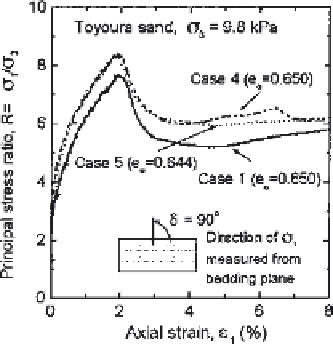Geoscience Reference
In-Depth Information
Figure 4
Results from plane strain compression tests on Toyoura sand.
To observe the deformation and displacement of sand layers, horizontal
layers of black-dyed Toyoura sand having a thickness of 10mm were prepared at
a vertical spacing of 50 mm in a width of about 30 mm both adjacent to the
transparent side wall and at the center of the backfill.
After the subsoil layer was prepared, the sand located beneath the bottom of
the model retaining wall was trimmed to have a level surface, and then the model
wall was carefully placed. The backfill layer was then prepared in the same way
as the subsoil layer. For the reinforced soil walls, a temporary steel frame was
used to support the wall during preparation of the backfill, which was removed
before applying seismic loads. Each reinforcement layer was placed horizontally
on the temporary level surface of the backfill when the height of the backfill
became the respective specified level.
After finishing the filling of sand, the surface of the backfill was trimmed to
the prescribed geometry, and a surcharge of 1 kPa was applied by placing lead
shots on the surface of the backfill to simulate such a structure as the railway
ballast fill. To separate sand from the lead shots, 0.2-mm-thick rubber membranes
were placed between them.
5.2 Seismic Load Application
Seismic loads were applied by shaking the sand box horizontally with an irregular
base acceleration. A strong motion that was recorded as N-S component at Kobe
Marine Meteorological Observation Station during the 1995 Hyogoken-Nanbu
earthquake was employed as the base acceleration
(Fig. 5a)
.
Its amplitude and










Search WWH ::

Custom Search